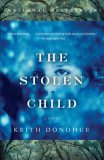Summary | Excerpt | Reading Guide | Reviews | Beyond the Book | Readalikes | Genres & Themes | Author Bio

A Novel
by Keith DonohueCHAPTER 1
Don’t call me a
fairy. We don’t like to be called fairies anymore. Once upon a time, fairy
was a perfectly acceptable catchall for a variety of creatures, but now it has
taken on too many associations. Etymologically speaking, a fairy is something
quite particular, related in kind to the naiads, or water nymphs, and while of
the genus, we are sui generis. The word fairy is drawn from fay
(Old French fee), which itself comes from the Latin Fata, the
goddess of fate. The fay lived in groups called the faerie, between the heavenly
and earthly realms.
There exist in this world a range of sublunary spirits that carminibus coelo
possunt deducere lunam, and they have been divided since ancient times into
six kinds: fiery, aerial, terrestrial, watery, subterranean, and the whole class
of fairies and nymphs. Of the sprites of fire, water, and air, I know next to
nothing. But the terrestrial and underground devils I know all too well, and of
these, there is infinite variety and attendant myth about their behavior,
custom, and culture. Known around the world by many different names--Lares,
genii, fauns, satyrs, foliots, Robin Goodfellows, pucks, leprechauns, pukas,
sídhe, trolls--the few that remain live hidden in the woods and are rarely
seen or encountered by human beings. If you must give me a name, call me
hobgoblin.
Or better yet, I am a changeling--a word that describes within its own name what
we are bound and intended to do. We kidnap a human child and replace him or her
with one of our own. The hobgoblin becomes the child, and the child becomes a
hobgoblin. Not any boy or girl will do, but only those rare souls baffled by
their young lives or attuned to the weeping troubles of this world. The
changelings select carefully, for such opportunities might come along only once
a decade or so. A child who becomes part of our society might have to wait a
century before his turn in the cycle arrives, when he can become a changeling
and reenter the human world.
Preparation is tedious, involving close surveillance of the child, and of his
friends and family. This must be done unobserved, of course, and it’s best to
select the child before he begins school, because it becomes more complicated by
then, having to memorize and process a great deal of information beyond the
intimate family, and being able to mimic his personality and history as clearly
as mirroring his physique and features. Infants are the easiest, but caring for
them is a problem for the changelings. Age six or seven is best. Anyone much
older is bound to have a more highly developed sense of self. No matter how old
or young, the object is to deceive the parents into thinking that this
changeling is actually their child. More easily done than most people imagine.
No, the difficulty lies not in assuming a child’s history but in the painful
physical act of the change itself. First, start with the bones and skin,
stretching until one shudders and nearly snaps into the right size and body
shape. Then the others begin work on one’s new head and face, which require the
skills of a sculptor. There’s considerable pushing and pulling at the cartilage,
as if the skull were a soft wad of clay or taffy, and then the malicious
business with the teeth, the removal of the hair, and the tedious -re--weaving.
The entire process occurs without a gram of painkiller, although a few imbibe a
noxious alcohol made from the fermented mash of acorns. A nasty undertaking, but
well worth it, although I could do without the rather complicated rearrangement
of the genitals. In the end, one is an exact copy of a child. Thirty years ago,
in 1949, I was a changeling who became a human again.
I changed lives with Henry Day, a boy born on a farm outside of town. On a late
summer’s afternoon, when he was seven, Henry ran away from home and hid in a
hollow chestnut tree. Our changeling spies followed him and raised the alarm,
and I transformed myself into his perfect facsimile. We grabbed him, and I
slipped into the hollowed space to switch my life for his. When the search party
found me that night, they were happy, relieved, and proud-not angry, as I had
expected. "Henry," a -red--haired man in a fireman’s suit said to me as I
pretended to sleep in the hiding place. I opened my eyes and gave him a bright
smile. The man wrapped me in a thin blanket and carried me out of the woods to a
paved road, where a fire truck stood waiting, its red light pulsing like a
heartbeat. The firemen took me home to Henry’s parents, to my new father and
mother. As we drove along the road that night, I kept thinking that if that
first test could be passed, the world would once again be mine.
Excerpted from The Stolen Child by Keith Donohue, Copyright © 2006 by Keith Donohue. Excerpted by permission of Nan A. Talese, a division of Random House, Inc. All rights reserved. No part of this excerpt may be reproduced or reprinted without permission in writing from the publisher.






Your guide toexceptional books
BookBrowse seeks out and recommends the best in contemporary fiction and nonfiction—books that not only engage and entertain but also deepen our understanding of ourselves and the world around us.